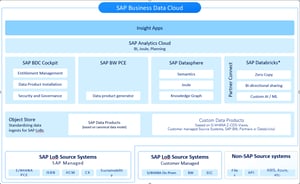Business Data Cloud
Die SAP Business Data Cloud ist eine fortschrittliche, vollständig verwaltete Software-as-a-Service-Lösung (SaaS), die es Unternehmen ermöglicht, Daten aus unterschiedlichsten Quellen zu bündeln und optimal zu nutzen. Sie vereint die leistungsstarken Funktionen von SAP Datasphere, SAP Analytics Cloud und SAP Business Warehouse in einer einheitlichen Plattform, die Ihnen tiefgreifende Einblicke über alle Geschäftsbereiche hinweg ermöglicht.
Die Business Data Cloud - innovatives Datenmanagement und Künstliche Intelligenz
Daten bilden das Fundament aller modernen Unternehmen. Sie sind ein unverrückbarer Grundstein für jegliche digitale Transformation und stellen die Basis für Entscheidungen aller Art im Unternehmen dar. Dafür ist es jedoch unabdingbar, dass ohne zeitlichen Verzug und mit dem richtigen Kontext auf einen möglichst vollständigen Datenraum zugegriffen werden kann.
Während kritische Unternehmensdaten oft in SAP-Systemen abliegen und besonderem Schutz unterliegen, operiert KI auf großen kaum zu überschauenden, unstrukturierten Datenmengen in der Cloud. Hier bietet die SAP nun mit der Business Data Cloud eine Software-as-a-Service-Lösung an, die beides vereint. Daten aus SAP-Systemen können gemeinsam mit Drittanbieterdaten analysiert und berichtet werden – und das, ohne die Semantik zu verlieren und in Echtzeit.
Ermöglicht wird das durch die Kombination der bisher eigenständigen Produkte SAP Datasphere, SAP Analytics Cloud und SAP Business Warehouse ergänzt um SAP Databricks und Joule in einem neuartigen allumfassenden Cloud-Produkt. Hierbei bildet die Datasphere die semantische Schicht, um Daten aus verschiedensten Systemen zusammenzuführen. Das Business Warehouse übernimmt die Orchestrierung der Daten, während die Analytics Cloud eine moderne Oberfläche für Dashboards und Planungslayouts bereitstellt. Mit Joule ist der SAP-eigene KI Agent tief im System integriert und die Kooperation mit Databricks bietet zudem die Möglichkeit erstklassige Machine-Learning-Tools auf den gesamten Datenbestand anzuwenden.
Dies alles wird als ein Ganzes zur Verfügung gestellt, das heißt ohne Systembrüche und mit einer einheitlichen Benutzeroberfläche.

Die SAP Business Data Cloud: Innovative Datenintegration für moderne Unternehmen
Die SAP Business Data Cloud verbindet technologische Fortschritte mit praktischer Anwendbarkeit, um Unternehmen die umfassende Verwaltung und Integration ihrer Daten zu ermöglichen. Diese vollständig verwaltete Software-as-a-Service-Lösung (SaaS) bietet die Möglichkeit, Daten aus unterschiedlichsten Quellen schnell und effizient zusammenzuführen, ohne dass dabei aufwendige IT-Prozesse erforderlich sind.
Mit einer benutzerfreundlichen Oberfläche ausgestattet, können Fachabteilungen Daten eigenständig modellieren und anreichern, während die IT-Abteilung gleichzeitig auf eine Vielzahl von Analytik- und Datenmanagement-Tools zurückgreifen kann. Durch diese Flexibilität ist die SAP Business Data Cloud gezielt auf die dynamischen Anforderungen moderner Unternehmen zugeschnitten.
Einsatzszenarien der SAP Business Data Cloud
Als cloudbasierte Lösung ermöglicht die SAP Business Data Cloud eine nahtlose Integration bestehender Datenquellen, ohne dass umfangreiche Migrationsprozesse erforderlich sind. Die Business Data Cloud kann parallel zu bestehenden On-Premise-Systemen, aber auch als eigenständige Lösung implementiert werden.
Durch die einfache Skalierbarkeit der Plattform können Unternehmen neue datenbasierte Prozesse schnell und effizient etablieren. Außerdem lässt sich die SAP Business Data Cloud mühelos in die SAP Business Technology Platform integrieren, was sie zu einer vielseitigen Lösung für die unterschiedlichsten Anwendungsfälle macht. Ob es sich um die Optimierung interner Geschäftsabläufe oder um die Gestaltung personalisierter Kundenerlebnisse handelt – die SAP Business Data Cloud unterstützt Unternehmen dabei, datengestützte Entscheidungen zu treffen und ihre Wettbewerbsfähigkeit zu steigern.
Durch die Zusammenführung von SAP Business Warehouse mit den strategischen Technologien SAP Datasphere und SAP Analytics Cloud bietet sich zudem ein besonders reibungsloser Migrationspfad von der On-Premise- in die Cloud-Welt. Während zunächst alle bestehenden Applikationen der BW-Plattform (7.50 oder BW/4HANA) weitergenutzt werden können, kann gleichzeitig die direkte Integration dieser Daten in den Gesamtkontext aller unternehmensweiten SAP- und Non-SAP-Daten erfolgen.
SAP Business Data Cloud: Die Zukunft der datengetriebenen Unternehmensstrategie
Insgesamt stellt die SAP Business Data Cloud eine leistungsstarke Lösung dar, die Unternehmen in die Lage versetzt, ihre Daten in vollem Umfang zu nutzen. Mit innovativen Funktionen, einer benutzerfreundlichen Oberfläche und der Flexibilität, bestehende Systeme zu integrieren, transformiert die SAP Business Data Cloud den Umgang mit Unternehmensdaten und ebnet den Weg für eine zukunftsorientierte Datenstrategie. So können Wettbewerbsvorteile erlangt und die Effizienz der Geschäftsoperationen gesteigert werden.
Die Stärken der SAP Business Data Cloud auf einen Blick
Die Business Data Cloud kombiniert modernste Technologien mit praktischer Anwendbarkeit. Die folgenden Punkte geben Ihnen einen kompakten Überblick über die wichtigsten Funktionen und Vorteile dieser leistungsstarken Plattform.
Zentrale Datenintegration
Die Business Data Cloud ermöglicht die nahtlose Verbindung und Integration von SAP-Daten mit Drittdaten, was eine ganzheitliche Sicht auf alle Unternehmensinformationen gewährleistet.
Echtzeitanalysen
Unternehmen profitieren von Datenanalysen in Echtzeit, die es ihnen ermöglichen, fundierte Entscheidungen schnell zu treffen und sich an dynamische Marktbedingungen anzupassen.
Optimierte Effizienz
Die Lösung eliminiert Dateninseln und fördert die Zusammenarbeit zwischen verschiedenen Abteilungen, was die Effizienz von Geschäftsprozessen steigert und redundante Arbeiten reduziert.Innovative KI-Integration
Durch die Zusammenarbeit mit Databricks integriert die Business Data Cloud leistungsstarke Funktionen, die es Unternehmen ermöglichen, Machine Learning und Künstliche Intelligenz effektiv zu nutzen, um tiefere Einblicke in ihre Daten zu erhalten.
Skalierbarkeit und Flexibilität
Als vollständig verwaltete SaaS-Lösung passt sich die Business Data Cloud den wachsenden Anforderungen von Unternehmen an und bietet die Flexibilität, Ressourcen nach Bedarf zu skalieren.
Verbesserte Datensicherheit
Mit den robusten Sicherheitsprotokollen von SAP wird der Schutz sensibler Unternehmensdaten gewährleistet, ohne auf zukunftsträchtige KI-Technologien verzichten zu müssen.
Unterstützung der digitalen Transformation
Die Business Data Cloud fungiert als Katalysator für die digitale Transformation von Unternehmen, indem sie eine moderne Infrastruktur bereitstellt, die eine reibungslose Migration ermöglicht und Innovationen fördert.
Zukunftssicherheit und Innovation
Regelmäßige Updates und Erweiterungen durch den SaaS-Ansatz.
